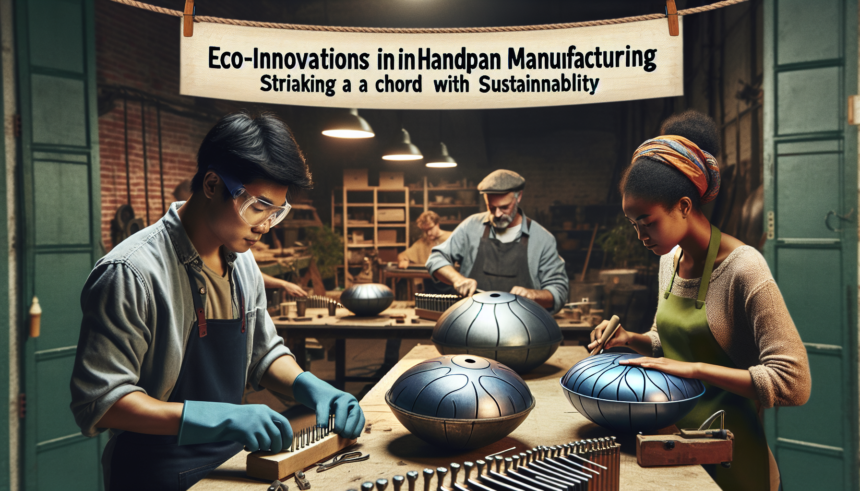<!DOCTYPE html>
<html lang="en">
<head>
<meta charset="UTF-8">
<meta name="viewport" content="width=device-width, initial-scale=1.0">
<title>Eco-Innovations in Handpan Manufacturing</title>
<style>
body {
font-family: Arial, sans-serif;
line-height: 1.6;
color: #333;
background-color: #f9f9f9;
margin: 0;
padding: 20px;
}
h2 {
color: #007B5E;
}
h3 {
color: #00563F;
}
p {
margin-bottom: 20px;
}
ul {
margin-bottom: 20px;
padding-left: 20px;
}
footer {
font-size: 0.9em;
color: #666;
}
</style>
</head>
<body>
<h2>Eco-Innovations in Handpan Manufacturing: Striking a Chord with Sustainability</h2>
<p>The handpan, often referred to as a UFO-shaped percussion instrument, has fascinated musicians and sound enthusiasts since its inception. Known for its ethereal tones and hypnotic melodies, the handpan has become a symbol of creative introspection and harmony with nature. As the world moves toward sustainable practices, the production processes of musical instruments like the handpan are also evolving. This article delves into the eco-innovations in handpan manufacturing, highlighting their alignment with sustainability goals.</p>
<h3>The Evolution of Handpan Manufacturing</h3>
<p>Handpans were first introduced in the early 2000s and have since captivated audiences with their unique sound. Traditionally, handpans are crafted from steel, molded into an elliptical shape, and tuned to precise scales to produce enchanting tones. However, conventional manufacturing techniques often entail significant environmental downsides, such as resource depletion and energy consumption.</p>
<p>The rise of eco-conscious consumers has propelled manufacturers to adopt more sustainable practices. By revisiting traditional methods, incorporating technological advancements, and utilizing eco-friendly materials, the handpan production process can be transformed to align with sustainability goals.</p>
<h3>Material Innovations</h3>
<p>One of the pivotal areas of innovation in handpan manufacturing is the choice of materials. Traditionally, steel is used for its durability and acoustic properties. However, the extraction and processing of steel contribute significantly to carbon emissions and resource depletion. Consequently, manufacturers are exploring alternative materials to mitigate these environmental impacts.</p>
<p>One promising option is the use of recycled metals. By sourcing metals from recycled sources, manufacturers can reduce the need for newly mined metals, thus conserving natural resources and minimizing environmentally damaging mining practices. Additionally, recycled materials require less energy to process, which further decreases their carbon footprint.</p>
<p>Another innovative approach is the application of coatings derived from natural or low-impact substances. These coatings can enhance the corrosion resistance and longevity of handpans without relying on harmful chemicals. Some manufacturers are experimenting with plant-based oils and waxes, which not only protect the instrument but also align with eco-friendly values.</p>
<h3>Energy-Efficient Manufacturing Processes</h3>
<p>The process of crafting a handpan involves several stages, including shaping, tuning, and finishing. Each of these steps can be optimized to reduce energy consumption and environmental impact.</p>
<p>Advanced technological tools such as computer-aided design (CAD) and 3D printing play vital roles in enhancing the precision and efficiency of handpan manufacturing. By employing these technologies, manufacturers can streamline their processes and minimize material waste. 3D printing, in particular, allows for accurate prototyping and testing of different designs before full-scale production, reducing the likelihood of resource wastage.</p>
<p>Moreover, manufacturers are exploring renewable energy sources to power production facilities. Solar panels, wind turbines, and other green energy solutions help offset the environmental footprint of handpan production. By transitioning to renewable energy, manufacturers can significantly decrease their dependency on fossil fuels, thereby supporting a more sustainable manufacturing ecosystem.</p>
<h3>Longevity and Repairability</h3>
<p>A key aspect of sustainable manufacturing is ensuring that products have long lifespans and are easy to repair. Durable products reduce the frequency of replacement, thereby minimizing waste and conserving resources.</p>
<p>In the context of handpans, this approach translates to meticulous craftsmanship to ensure the instruments remain robust even after prolonged use. Moreover, manufacturers are prioritizing designs that facilitate repairs, allowing musicians to easily replace damaged parts without discarding the entire instrument.</p>
<p>By offering repair services and guides, manufacturers empower consumers to extend the life of their handpans, reducing overall environmental impact. This not only fosters a culture of sustainability but also establishes lasting relationships between makers and musicians.</p>
<h3>Community Engagement and Social Responsibility</h3>
<p>Incorporating eco-innovations is not limited to technical and manufacturing processes; it also involves fostering a sense of community responsibility. Handpan manufacturers increasingly recognize the importance of engaging with their communities to promote sustainable practices.</p>
<p>Some companies are organizing workshops and educational events to raise awareness about sustainable manufacturing practices. By involving local communities and musicians in these efforts, manufacturers create a shared commitment to sustainability. Additionally, some brands allocate a portion of their profits to environmental initiatives, further aligning their business operations with ecological values.</p>
<h3>Conclusion</h3>
<p>The integration of eco-innovations into handpan manufacturing is a harmonious blend of tradition and modernity, showcasing a commitment to sustainability without compromising on quality and sound. By embracing recycled materials, optimizing production processes, and fostering community engagement, handpan manufacturers are leading the way in eco-friendly musical instrument production. As more manufacturers adopt these sustainable practices, the harmonious sounds of handpans will continue to resonate with a planet that is better cared for and preserved.</p>
<h2>FAQs</h2>
<h3>1. What are some sustainable materials used in handpan manufacturing?</h3>
<p>Manufacturers often use recycled metals and natural coatings, such as plant-based oils and waxes, to reduce environmental impact while maintaining the quality and longevity of the instruments.</p>
<h3>2. How do technological advancements contribute to sustainable handpan manufacturing?</h3>
<p>Technologies like CAD and 3D printing enable precise design and efficient production, minimizing material waste. These innovations also allow for accurate prototyping, reducing the risk of errors and resource wastage in large-scale production.</p>
<h3>3. Can using renewable energy sources substantially impact the sustainability of handpan manufacturing?</h3>
<p>Yes, utilizing renewable energy sources like solar or wind power can significantly lower the carbon footprint of manufacturing processes by decreasing reliance on fossil fuels, promoting a more sustainable production ecosystem.</p>
<h3>4. How do manufacturers ensure the longevity of handpans?</h3>
<p>By focusing on high-quality craftsmanship and offering designs that allow for easy repair and maintenance, manufacturers can ensure that handpans last longer and reduce the need for replacement, thereby minimizing waste.</p>
<h3>5. In what ways do handpan manufacturers engage with communities on sustainability issues?</h3>
<p>Beyond technical innovations, many manufacturers organize workshops, educational events, and support environmental initiatives, promoting sustainability awareness and fostering a sense of shared responsibility among musicians and local communities.</p>
<footer>
<p>© 2023 Handpan Innovations. All rights reserved.</p>
</footer>
</body>
</html>Eco-Innovations in Handpan Manufacturing: Striking a Chord with Sustainability

Leave a comment




